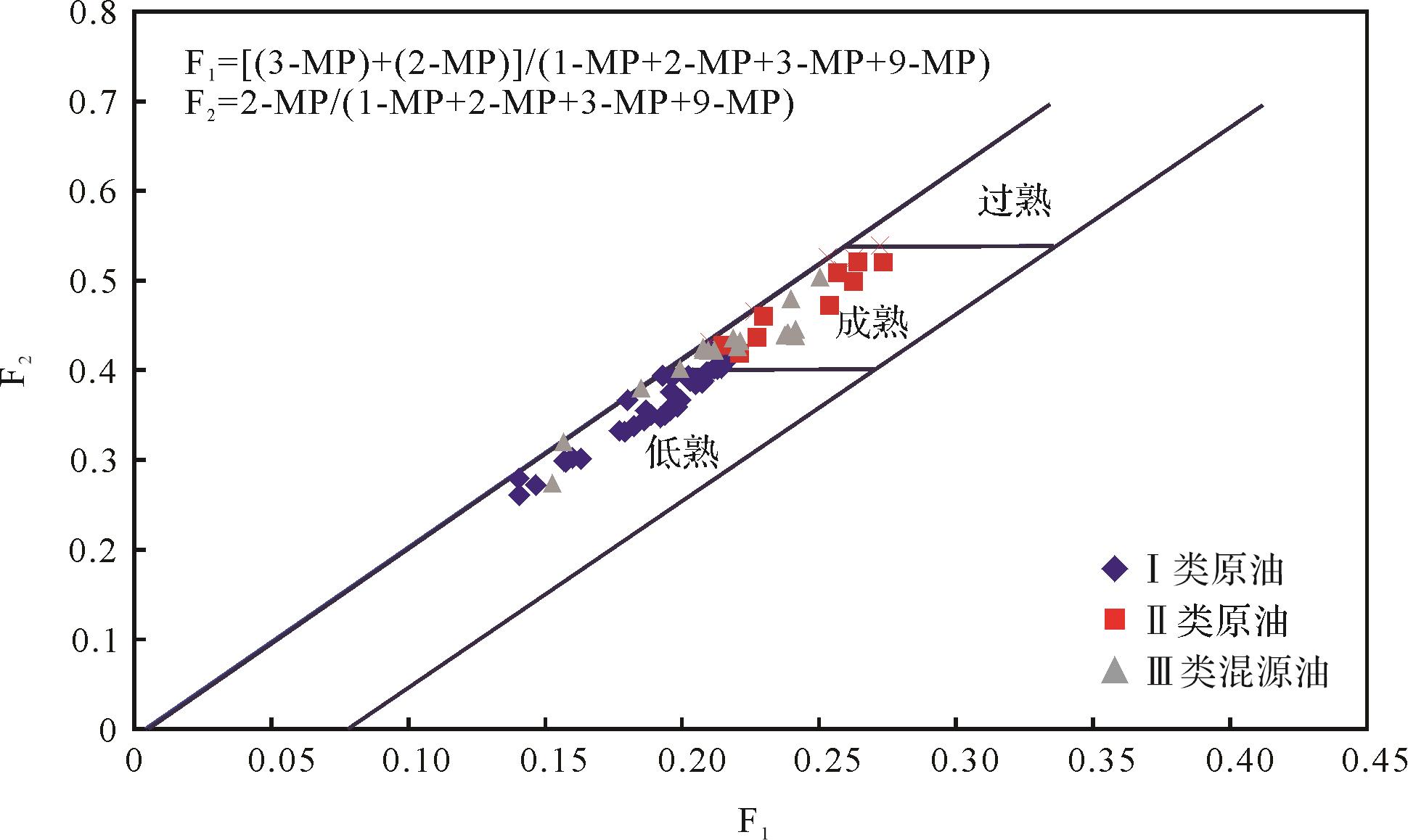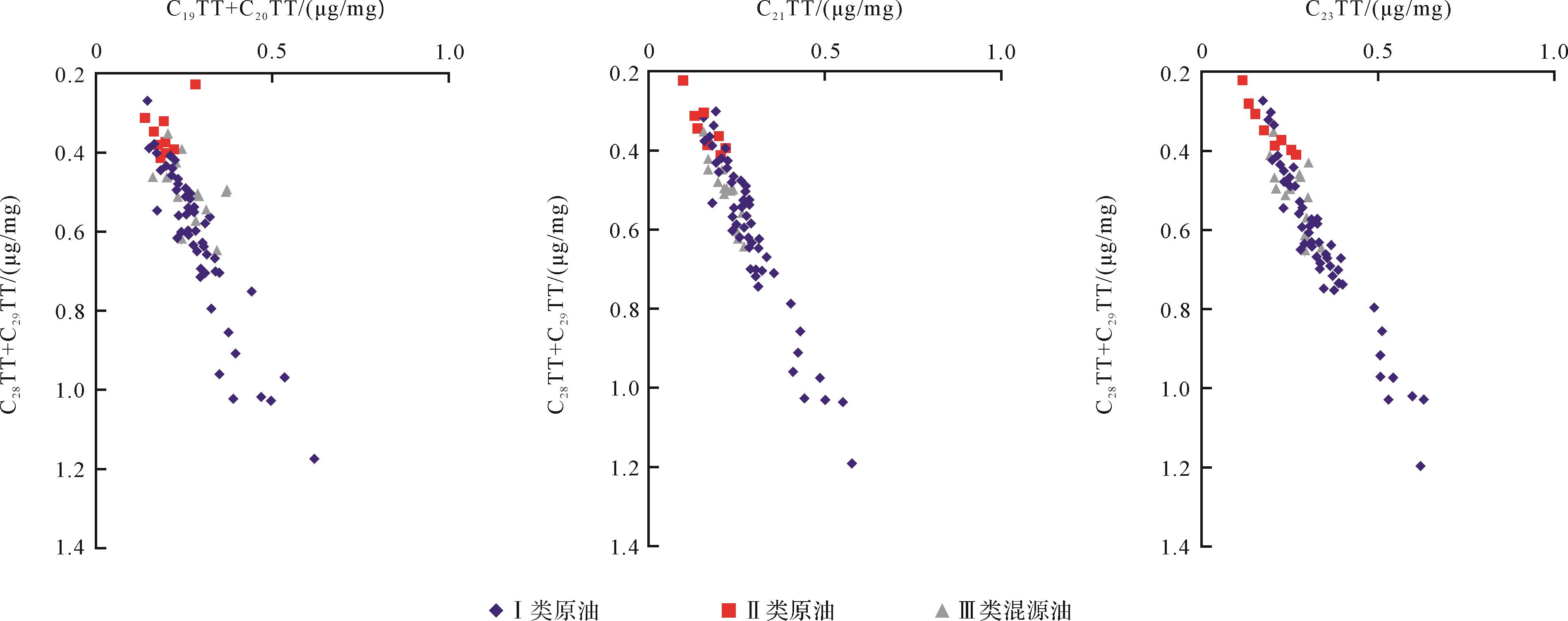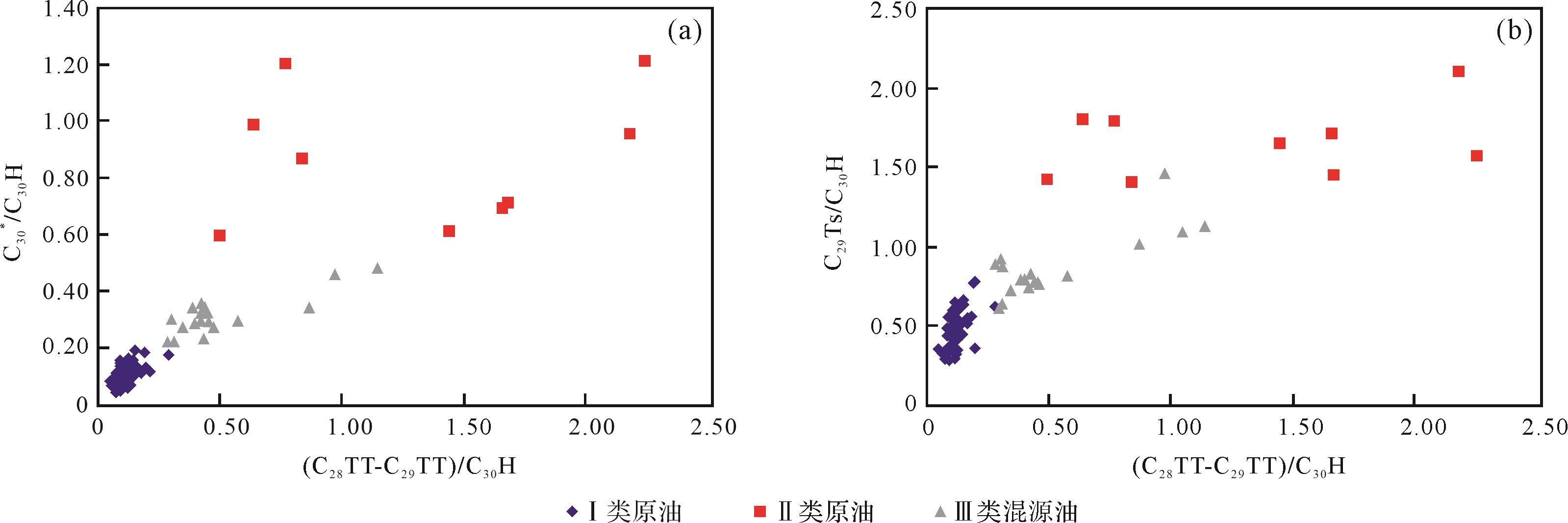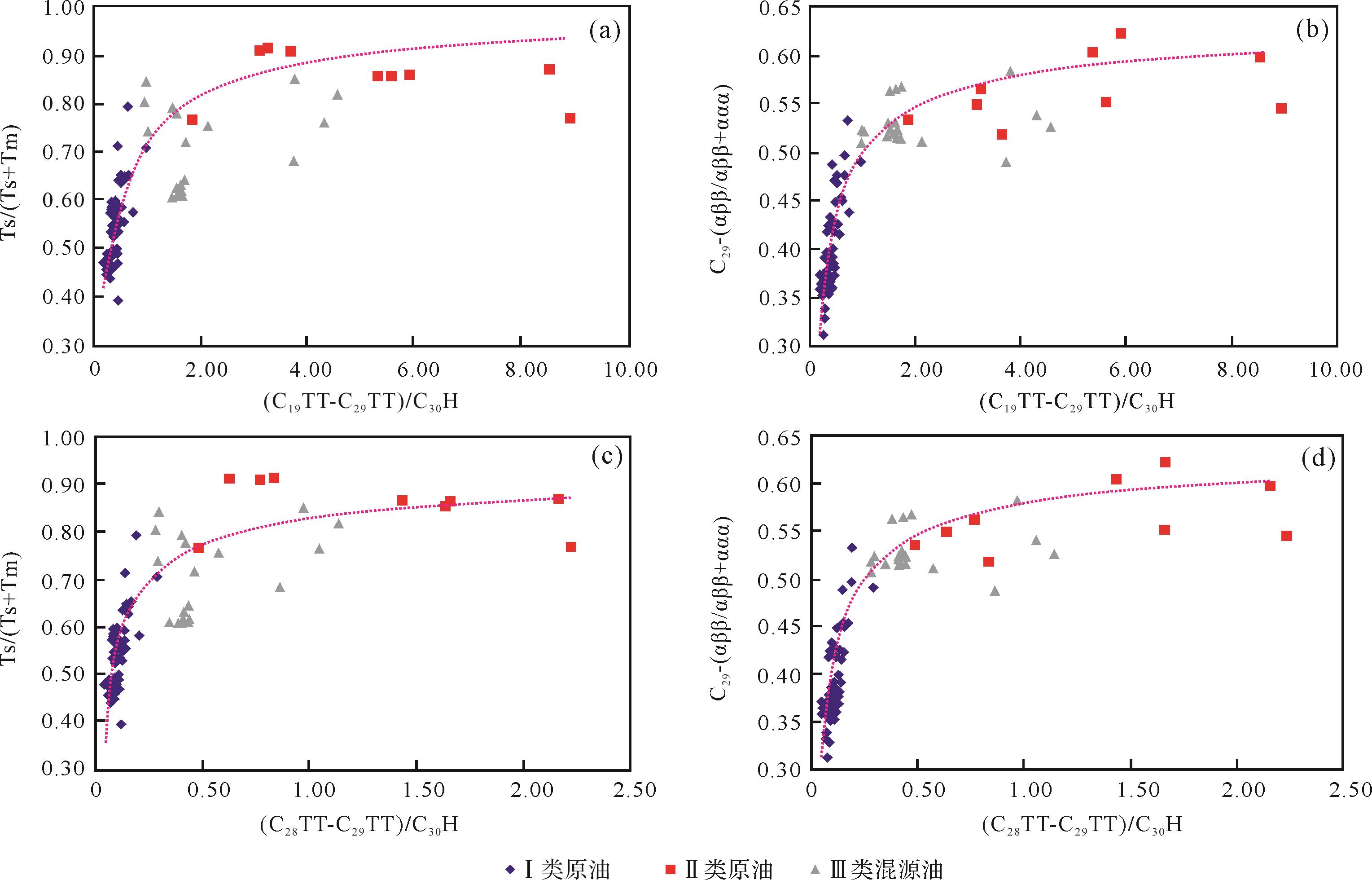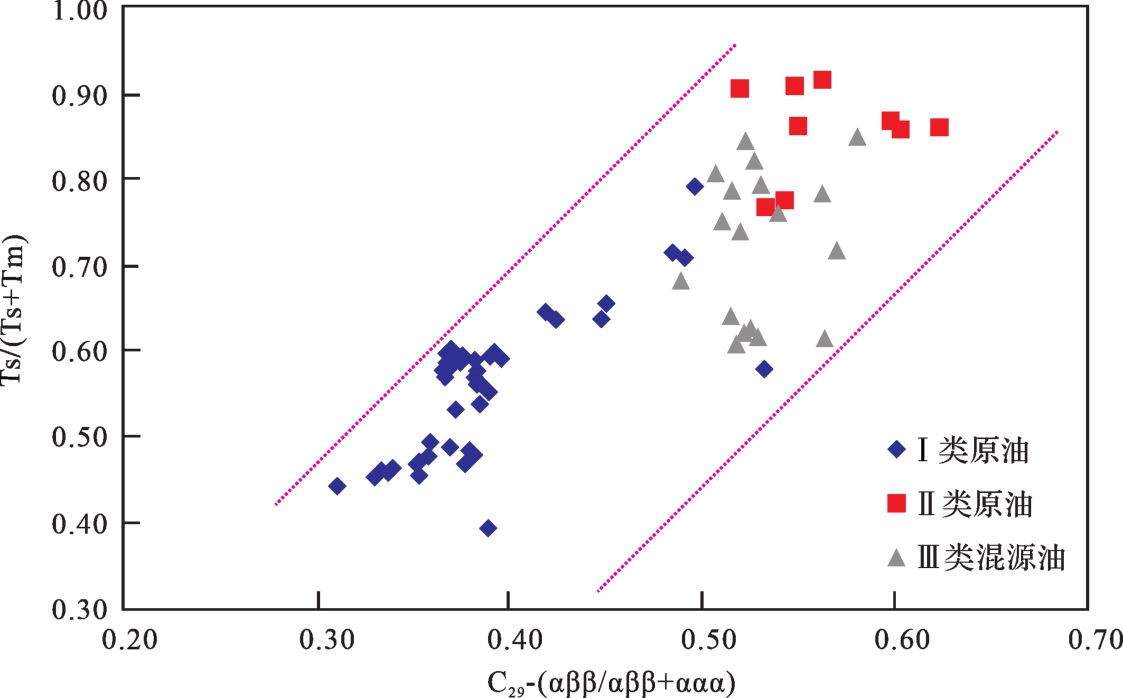HTML
-
三环萜烷是饱和烃重要组成部分之一,Anders et al.[1]在1971年首次于绿河页岩的抽提物中发现了三环萜烷;1983年,Moldowan et al. [2]研究发现加利福尼亚原油中的三环萜烷系列可以延伸到C45;十年后,de Grande et al.[3]在分析不同原油和烃源岩时发现三环萜烷的碳数至少可以延伸到C54,且分布范围在C19-C54的三环萜烷中,湖泊咸水和海相碳酸盐环境中三环萜烷的相对丰度较高,表明其前身物受到沉积水体盐度的控制;与此同时,国内学者开始将三环萜烷化合物应用于原油的生源输入及油源对比等研究。1999年,在泌阳坳陷第三系湖相碳酸盐岩中检测到丰富的C20TT-C25TT,并提出利用三环萜烷参数(TCT)来确定未成熟和低成熟碳酸盐岩烃源岩的热成熟度[4]。进入21世纪以来,国内外学者对三环萜烷的研究更加深入,认为三环萜烷参数可用来划分原油类型,表征原油的成因,且大多数研究认为沉积相类型的差异可能造成三环萜烷分布模式的不同,因此三环萜烷可用于判断不同的沉积环境。现有的研究表明,海相和咸水湖相沉积物中的三环萜烷峰型以C23TT为主,淡水湖相沉积物中的三环萜烷峰型以C21TT为主,而煤系地层或以高等植物输入为主的陆相沉积物中三环萜烷的峰型则以C19TT-C20TT的短链三环萜烷为主[5]。
前人的研究表明,三环萜烷类化合物在地质体中蕴藏着丰富的地质—地球化学意义,通过对三环萜烷类化合物与特定生物标志物的对比研究,可以进行油源对比、烃源岩成因类型、沉积环境、生物降解和热成熟度的判断与评价[6⁃7],但目前还没有对原油中丰富三环萜烷的来源和沉积环境进行明确的定义,Philp et al.[8]在1986年提出三环萜烷是海洋藻类或细菌的指示物,浓度较高的不是来自咸水沉积环境的原油,而是来自淡水—微咸水沉积环境的原油。并且全球范围内高碳数三环萜烷(C28TT-C29TT)较C19TT-C20TT、C21TT、C23TT相对百分含量高的情况比较少见,但在松辽盆地梨树断陷的湖相原油中却普遍存在。本文以松辽盆地梨树断陷的湖相原油样品为例,研究高含量高碳数三环萜烷相对丰度的变化,系统剖析了梨树断陷原油中三环萜烷的分布特征,并对高碳数三环萜烷的主控因素进行了探讨,为沉积环境、有机质来源、热演化程度等研究提供了新思路,对该区湖相原油的精细划分及对主力烃源岩的厘定和油气勘探具有重要的意义。
-
松辽盆地是中国东部大型中、新生代沉积盆地,是我国最大的陆相含油气盆地之一(图1)[9⁃12]。梨树断陷是松辽盆地的一个次级构造单元,下有四个次级构造单元:北部斜坡带、中央构造带、东部斜坡带和桑树台洼陷[13]。该断陷地理位置上位于吉林省公主岭市秦家屯镇和八屋镇之间,构造上位于松辽盆地东南隆起区,是晚侏罗世—早白垩世地层发育最全、有机质演化程度最高的断陷盆地之一[14]。

Figure 1. Territorial tectonic location and division of internal tectonic units in Lishu Fault Depression, Songliao Basin (modified from Chen et al.[12])
梨树断陷为断坳叠置的复合型含油气盆地,经历了5个构造演化阶段:断陷期、断坳转换期、坳陷期、构造反转期和萎缩期[15⁃16]。该断陷沉降幅度大,沉积发育,其中断陷构造层发育上侏罗统火石岭组(T3h),下白垩统沙河子组(K1sh)、营城组(K1yc)和登娄库组(K1d);坳陷构造层发育下白垩统泉头组(k1q),上白垩统青山口组(k2qn)、姚家组(K2y)和嫩江组(K2n)[12,17]。其中沙河子组和营城组为区内主力烃源岩,发育深湖相—半深湖相碎屑沉积;登娄库组为断陷萎缩阶段沉积,发育浅湖相—三角洲相碎屑沉积,烃源岩不发育[18⁃19]。从沙河子组到营城组再到登娄库组,古气候与古植被均经历一系列变化,表现为气候逐渐变干,气温逐渐变高,湖水在登娄库组中后期呈旋回式变化,由原来的淡—微咸水变成半咸水[13]。
-
在松辽盆地梨树断陷采集了71个原油样品,主要取样点在秦家屯、太平庄、八屋、四五家子和七棵树,主要分布层位为K1h、K1sh、K1yc、K1d及K1q。
原油样品气相色谱和色谱—质谱(GC-MS)分析实验条件如下。
色谱分析:HP6890N气相色谱仪,HP-PONA毛细柱,0.20 mm×50 m,膜厚0.5 μm,初始温度50 ℃,恒温3 min,以5 ℃/min速率升温至300 ℃后恒温25 min,氮气流速为1.0 mL/min,分流比为20∶1,进样温度300 ℃,FID检测器温度为300 ℃。
饱和烃定量色谱—质谱分析:色谱—质谱仪型号为HP GC 6890/5973MSD。色谱柱为HP-5MS弹性石英毛细柱(30 m×0.25 mm×0.25 μm),以脉冲不分流方式进样,脉冲压力为15 psi,进样器温度300 ℃,He为载气,流速1 mL/min。升温程序如下:初始温度50 ℃,恒温2 min后,以3 ℃/min的速率升温至310 ℃,并维持恒温18 min,EI电离方式,电离能量70 eV。
芳烃定量色谱—质谱分析:色谱—质谱仪型号为HP GC6890/5973MSD。色谱柱为HP-5MS 60 m×0.25 mm×0.25 μm,汽化室温度为290 ℃,进样方式是脉冲不分流进样且采用恒流模式,载气流速为1 mL/ min。柱炉温的升温程序为:以20 ℃/min 升至100 ℃,然后再以3 ℃/ min升至310 ℃,恒温18 min。质谱采用EI 电离方式,电子能量为70 eV,接口温度为280 ℃,采集方式为全扫描模式,扫描质量范围为50~450 amu。
-
针对松辽盆地梨树断陷原油成因类型的划分,已有不同的学者根据其生标组合特征做出详细研究,本文采用Zhang et al.[20]对梨树断陷原油成因类型划分的标准,筛选出4个代表性参数:Ts/Tm、C29Ts/C29H、G(伽马蜡烷)/C30H、C30*(重排藿烷)/C30H,并根据其组成特征的差异性,将研究区原油划分为3种类型,具体的原油判识指标见表1。其中Ⅰ类原油主要分布在梨树断陷东部的秦家屯、四五家子地区,主要分布层位为K1d和K1q;Ⅱ类原油主要分布在梨树断陷中西部的皮家、八屋地区,主要分布层位为K1yc和K1sh;Ⅲ类原油主要为Ⅰ类和Ⅱ类原油的混源油,主要分布在梨树断陷中部和北东部的八屋、太平庄、七棵树等地区,主要分布层位为K1yc。
生标参数指标 Ⅰ类原油(44个) Ⅱ类原油(9个) Ⅲ类混源油(18个) Ts/Tm <1.8 >4.0 1.8~4.0 C29Ts/C29H <0.6 >1.0 0.6~1.0 C30*/C30H <0.2 >0.5 0.2~0.5 G/C30H <0.4 >0.5 0.4~0.5 根据研究区原油生物标志化合物的参数(表2),Ⅰ类原油的C30*/C30H<0.2(平均值为0.11,n=44);Ⅱ类原油C30*/C30H>0.5(平均值为0.88,n=9);Ⅲ类混源油的C30*/C30H在Ⅰ类原油和Ⅱ类原油之间(平均值为0.32,n=18)。整体上,Ⅰ类原油具有较低的ΣTT/H(藿烷)、G/C30H、C29Ts/C29H、Ts/Tm、C30*/C30H和C29甾烷-αββ/(αββ+ααα)比值,但具有相对较高的C24TeT(四环萜烷)/C26TT;Ⅱ类原油则与之不同,ΣTT/H、G/C30H、C29Ts/C29H、Ts/Tm、C30*/C30H和C29甾烷-αββ/(αββ+ααα)的比值较高,而C24TeT/C26TT值偏低,Ⅲ类混源油的各项参数则在Ⅰ类原油与Ⅱ类原油之间。
原油类型 井号 地区 深度/m 层位 生物标志化合物参数 1 2 3 4 5 6 7 8 9 10 11 12 13 14 Ⅰ类原油 W5 四五家子 481.0~598.0 K1q2 0.40 0.45 0.82 0.31 0.06 0.03 0.33 0.70 0.44 0.79 0.51 0.34 0.50 3.10 SN119 太平庄 1 268.5~1 272.5 K1yc5 0.65 0.49 0.95 0.34 0.07 0.04 0.37 1.00 0.16 1.17 0.38 0.24 0.25 2.48 QK1-2 秦家屯 1 127.0~1 168.8 K1q1 0.50 0.47 0.89 0.46 0.10 0.05 0.38 1.08 0.28 0.98 0.47 0.21 0.20 2.19 SN66 四五家子 1 497.7~1 522.5 K1yc2 0.33 0.64 1.75 0.45 0.11 0.05 0.43 0.80 0.33 0.78 0.50 0.18 0.23 3.09 QK122-20 秦家屯 1 011.0~1 023.0 K1q2 0.42 0.58 1.38 0.52 0.12 0.06 0.36 1.10 0.23 0.86 0.45 0.23 0.21 2.55 BK20-6 八屋 2 128.0~2 171.0 K1yc5 0.33 0.66 1.91 0.54 0.12 0.07 0.45 0.81 0.42 0.78 0.50 0.19 0.24 3.47 QK142-20 秦家屯 1 016.2~1 033.0 K1q1 0.41 0.60 1.47 0.52 0.13 0.06 0.39 1.11 0.24 1.01 0.44 0.22 0.20 3.02 QK121-6 秦家屯 1 069.0~1 088.0 K1q2 0.40 0.59 1.46 0.52 0.14 0.07 0.38 1.14 0.26 0.87 0.47 0.21 0.19 3.10 SW12 七棵树 1 332.1~1 337.2 K1h 0.73 0.48 0.91 0.35 0.08 0.04 0.36 1.03 0.25 1.05 0.36 0.27 0.20 2.05 Ⅱ类原油 SW9 七棵树 2 282.2~2 295.1 K1sh 0.14 0.77 3.33 1.56 1.22 0.74 0.54 0.90 0.69 0.75 0.73 0.24 0.27 5.09 HS2 七棵树 2 180.8~2 198.6 K1sh 0.42 0.76 3.25 1.40 0.60 0.31 0.53 1.22 0.31 1.28 0.43 0.15 0.12 3.53 SW1 八屋 1 689.7~1 855.5 K1yc3 0.25 0.91 9.95 1.40 0.87 0.35 0.52 1.11 0.50 2.00 0.50 0.14 0.13 9.00 SW103-12-2 八屋 1 867.0~1 870.0 K1yc5 0.29 0.91 10.19 1.80 1.00 0.41 0.55 1.24 0.42 2.97 0.41 0.14 0.12 6.12 SW103 八屋 1 907.8~1 915.6 K1yc5 0.28 0.91 10.44 1.79 1.21 0.60 0.56 1.25 0.52 2.55 0.42 0.14 0.12 6.57 BK60-2 八屋 2 117.4~2 141.3 K1yc3 0.13 0.86 6.21 1.65 0.62 0.27 0.60 0.77 0.71 0.97 0.66 0.16 0.21 9.27 BK61-2 八屋 2 141.5~2 173.2 K1yc3 0.11 0.86 6.03 1.72 0.70 0.37 0.55 0.77 0.99 0.96 0.68 0.14 0.18 15.24 BK60 八屋 2 137.0~2 163.5 K1yc3 0.11 0.86 6.15 1.45 0.71 0.31 0.62 0.74 0.87 0.90 0.69 0.14 0.19 10.34 BK62-3 八屋 2 178.0~2 181.6 K1yc3 0.10 0.87 6.64 2.10 0.97 0.49 0.60 0.74 1.10 1.05 0.70 0.14 0.19 12.46 Ⅲ类混源油 WK17-4 四五家子 2 013.3~2 022.0 K1yc5 0.20 0.72 2.56 0.76 0.28 0.11 0.57 0.74 0.60 1.02 0.60 0.16 0.22 6.04 SN203 八屋 1 874.5~1 882.1 K1yc5 0.22 0.79 3.80 0.75 0.30 0.13 0.53 0.86 0.55 1.21 0.56 0.13 0.15 6.58 SW8 七棵树 1 927.6~1 942.7 K1sh 0.24 0.62 1.62 0.78 0.30 0.14 0.53 0.94 0.49 0.79 0.65 0.21 0.22 5.37 BK203-9 八屋 1 859.5~1 864.1 K1yc5 0.22 0.79 3.69 0.76 0.33 0.14 0.52 0.87 0.52 1.14 0.57 0.13 0.15 6.34 TG1 七棵树 1 903.9~1 906.9 K1yc5 0.23 0.64 1.79 0.82 0.35 0.15 0.52 0.93 0.53 1.00 0.61 0.20 0.22 5.81 BK20-5 八屋 2 116.2~2 121.1 K1yc5 0.15 0.76 3.23 1.10 0.46 0.24 0.54 0.81 0.80 1.33 0.66 0.16 0.20 7.36 SW6 八屋 2 018.3~2 029.2 K1yc5 0.15 0.85 5.71 1.46 0.46 0.25 0.58 0.81 0.68 1.06 0.62 0.15 0.19 10.98 注: 1.C24TeT/C26TT; 2.Ts/(Ts+Tm); 3.Ts/Tm; 4.C29Ts/C29H; 5.C30*/C30H; 6.C29*/C30H; 7.C29⁃αββ/(αββ+ααα); 8.Pr/Ph; 9.G/C30H; 10.(C19TT+C20TT)/C23TT; 11.ETR; 12.Pr/nC17; 13.Ph/nC18; 14.MDR;其中ETR=(C28TT+C29TT)/(C28TT+C29TT+Ts);MDR=(4-MDBT)/(1-MDBT)。对比m/z191质量色谱图(图2),根据三环萜烷和藿烷的分布特征可以明显看出,I类原油三环萜烷的含量明显低于藿烷,总三环萜烷(ΣTT)/17α(H)-藿烷(C30H)的比值范围为0.20~0.99(平均值为0.40,n=44),Ⅱ类原油三环萜烷的含量相对藿烷则明显增大,ΣTT/C30H比值范围为1.88~8.91(平均值为5.14,n=9);Ⅲ类混源油三环萜烷相对藿烷的含量在I类原油和Ⅱ类原油之间,ΣTT/C30H比值范围为0.96~4.57(平均值为2.06,n=18)。从I类原油到Ⅱ类原油,ΣTT/C30H的比值逐渐增大,三环萜烷相对藿烷的含量逐渐增加,高碳数三环萜烷的相对丰度((C28-C29)TT/C30H)也在逐渐增大(表3)。

Figure 2. Mass chromatograms (m/z 191) of terpenoids from typical of types I and II crude oils in Lishu Fault Depression
原油类型 井号 地区 井深/m 层位 C19TT/C30H C20TT/C30H C21TT/C30H C22TT/C30H C23TT/C30H C24TT/C30H C25TT/C30H C26TT/C30H C28TT/C30H C29TT/C30H (C28-C29)TT/C30H ΣTT/C30H Ⅰ类原油 W5 四五家子 481.0~598.0 K1q2 0.01 0.02 0.04 0.01 0.04 0.03 0.02 0.03 0.03 0.04 0.07 0.28 SN119 太平庄 1 268.5~1 272.5 K1yc5 0.02 0.02 0.03 0.00 0.03 0.02 0.02 0.02 0.02 0.04 0.06 0.22 QK1-2 秦家屯 1 127.0~1 168.8 K1q1 0.02 0.04 0.05 0.01 0.05 0.04 0.03 0.04 0.04 0.07 0.10 0.37 SN66 四五家子 1 497.7~1 522.5 K1yc2 0.02 0.04 0.06 0.01 0.08 0.05 0.04 0.06 0.06 0.08 0.13 0.50 QK122-20 秦家屯 1 011.0~1 023.0 K1q2 0.01 0.03 0.04 0.01 0.05 0.03 0.03 0.04 0.04 0.07 0.10 0.34 BK20-6 八屋 2 128.0~2 171.0 K1yc5 0.02 0.05 0.08 0.01 0.09 0.07 0.05 0.08 0.07 0.10 0.17 0.63 QK142-20 秦家屯 1 016.2~1 033.0 K1q1 0.02 0.04 0.05 0.01 0.06 0.04 0.03 0.05 0.04 0.07 0.11 0.39 QK121-6 秦家屯 1 069.0~1 088.0 K1q2 0.02 0.04 0.05 0.01 0.06 0.04 0.03 0.05 0.05 0.08 0.12 0.42 SW12 十屋 1 332.1~1 337.2 K1h 0.01 0.02 0.02 0.01 0.03 0.02 0.02 0.02 0.02 0.04 0.06 0.20 Ⅱ类原油 SW9 七棵树 2 282.2~2 295.1 K1sh 0.26 0.77 1.17 0.22 1.36 0.98 0.73 1.17 1.02 1.22 2.24 8.91 HS2 十屋 2 180.8~2 198.6 K1sh 0.12 0.20 0.22 0.05 0.25 0.20 0.14 0.21 0.18 0.30 0.49 1.88 SW1 八屋 1 689.7~1 855.5 K1yc3 0.53 0.37 0.39 0.07 0.45 0.41 0.25 0.38 0.36 0.48 0.83 3.67 SW103-12-2 八屋 1 867.0~1 870.0 K1yc5 0.66 0.39 0.30 0.06 0.35 0.30 0.16 0.30 0.25 0.38 0.63 3.14 SW103 八屋 1 907.8~1 915.6 K1yc5 0.53 0.46 0.31 0.04 0.39 0.31 0.17 0.28 0.32 0.45 0.77 3.25 BK60-2 八屋 2 117.4~2 141.3 K1yc3 0.28 0.46 0.69 0.09 0.77 0.56 0.42 0.65 0.70 0.74 1.44 5.35 BK61-2 八屋 2 141.5~2 173.2 K1yc3 0.34 0.39 0.62 0.09 0.76 0.59 0.43 0.71 0.79 0.86 1.66 5.59 BK60 八屋 2 137.0~2 163.5 K1yc3 0.36 0.37 0.67 0.09 0.82 0.67 0.48 0.76 0.81 0.86 1.67 5.89 BK62-3 八屋 2 178.0~2 181.6 K1yc3 0.60 0.68 1.00 0.14 1.23 0.93 0.68 1.10 1.08 1.09 2.17 8.54 Ⅲ类混源油 WK17-4 四五家子 2 013.3~2 022.0 K1yc5 0.11 0.13 0.19 0.03 0.24 0.19 0.14 0.21 0.21 0.25 0.47 1.72 SN203 八屋 1 874.5~1 882.1 K1yc5 0.10 0.12 0.16 0.03 0.19 0.16 0.11 0.19 0.17 0.24 0.41 1.48 SW8 七棵树 1 927.6~1 942.7 K1sh 0.05 0.15 0.22 0.05 0.24 0.18 0.13 0.20 0.17 0.26 0.43 1.64 BK203-9 八屋 1 859.5~1 864.1 K1yc5 0.10 0.12 0.16 0.03 0.19 0.16 0.11 0.19 0.17 0.25 0.43 1.48 TG1 七棵树 1 903.9~1 906.9 K1yc5 0.10 0.14 0.23 0.03 0.24 0.17 0.13 0.20 0.19 0.24 0.43 1.67 BK20-5 八屋 2 116.2~2 121.1 K1yc5 0.37 0.44 0.49 0.08 0.60 0.45 0.32 0.51 0.47 0.59 1.05 4.31 SW6 八屋 2 018.3~2 029.2 K1yc5 0.26 0.32 0.45 0.06 0.55 0.41 0.31 0.48 0.46 0.51 0.97 3.80 除此之外,Ⅰ类原油与Ⅱ类原油成熟度也表现出一定的差异。芳烃参数F1、F2常用于判断原油成熟度,该参数对各个成熟度阶段的样品均具有较好的指示作用[21⁃23]。从图3可以看出,梨树断陷原油总体处于低熟—成熟阶段,I类原油处于低熟—成熟阶段,Ⅱ类原油处于成熟阶段,且I类原油与Ⅱ类原油成熟度变化连续性较好,表明整体上研究区I类原油和II类原油的成熟度存在一定的差异,但差异较小。
-
梨树断陷不同类型原油中三环萜烷的分布模式主要表现出以C28-29TT的优势分布(C19TT<C23TT<C28-29TT),仅有个别八屋区块中的Ⅱ类原油样品表现出以C19TT的优势分布(C19TT>C23TT<C28-29TT),这些不同的萜烷分布模式可能反映了沉积时母源的差异和成熟度的影响。此外,不同类型原油中三环萜烷浓度也存在一定的差异,总体而言,Ⅰ类原油三环萜烷的浓度明显高于Ⅱ类原油,具体表现为Ⅰ类原油高碳数三环萜烷(C28TT-C29TT)、低碳数三环萜烷(C19TT-C20TT、C21TT、C23TT)的浓度均分别高于Ⅱ类原油(图4)。

Figure 4. Relationship between tricyclic terpane concentration in different types of crude oil from Lishu Fault Depression
尽管不同类型原油中三环萜烷浓度差别很大,但不同类型原油三环萜烷相对百分含量的数值差别不大,且高碳数三环萜烷的相对百分含量均很高,就其百分含量而言(表4),不同类型原油高碳数三环萜烷相对百分含量占整体三环萜烷的27%以上。整体上,研究区内不同类型原油样品中高碳数三环萜烷(C28TT-C29TT)相对含量均高于低碳数三环萜烷(C19TT-C20TT、C21TT、C23TT)。
三环萜烷系列化合物 Ⅰ类原油 Ⅱ类原油 Ⅲ类混源油 C19TT 4.32 5.00 4.98 C20TT 8.49 8.27 8.47 C21TT 12.82 11.97 12.23 C23TT 14.77 14.17 14.41 C28TT 10.71 12.48 11.65 C29TT 17.00 14.43 15.46 C28TT-C29TT 27.85 27.00 27.10 -
从沉积学的角度来看,梨树断陷主要发育湖相的沉积环境,沉积水体表现为微咸水—咸水性质。类异戊二烯烷烃中的姥鲛烷(Pr)和植烷(Ph)、伽马蜡烷指数及三环萜烷生物标志化合物参数都可以用来反映烃源岩的沉积环境[24]。
姥植比(Pr/Ph)是反映氧化—还原性较为有效的参数,通常将Pr/Ph≤1表示为还原环境,1<Pr/Ph≤2.5表示为弱氧化—弱还原环境,Pr/Ph>2.5表示为氧化环境[25]。松辽盆地梨树断陷不同类型原油的Pr/Ph值范围为0.67~1.25,平均值为0.94,由姥植比范围可见,梨树断陷的沉积环境较为相似,不同类型原油均表现为弱氧化—弱还原环境。Ⅱ类原油和Ⅲ类原油大多数样品其高碳数(C28TT-C29TT)三环萜烷的相对丰度((C28TT-C29TT)/C30H)与姥植比有一定的负相关性(图5a),整体上,从I类原油到Ⅱ类原油,研究区原油样品表现出偏还原的环境更利于高碳数三环萜烷富集的现象,但其相关性可能与其分布范围较窄无关。除姥植比外,Pr/nC17与Ph/nC18比值不仅可以用于氧化还原环境的判识,还可以评价有机质的热演化阶段[26]。Pr/nC17与Ph/nC1关系图亦显示该研究区原油均形成于弱氧化—弱还原沉积环境(图5b),说明有机质沉积时水体的氧化还原性并不是影响梨树断陷原油三环萜烷相对丰度的主要因素。
伽马蜡烷是一种非藿烷类的三萜烷,通常认为是通过四膜虫醇的脱水和加氢作用而形成的[27⁃28],高含量的伽马蜡烷通常与高盐沉积环境以及某种嗜盐菌的发育有关[29],其丰度可以指示沉积环境的盐度[30⁃33],且伽马蜡烷指数(G/C30H)越高,反映古盐度也越高[34⁃36]。梨树断陷的G/C30H比值范围在0.31~1.10,平均值为0.41,整体上研究区介于微咸水—咸水湖相环境。I类原油G/C30H比值介于0.16~0.46,平均值为0.3;Ⅱ类原油的G/C30H介于0.31~1.10,平均值为0.68;Ⅲ类原油的G/C30H介于0.38~0.84,平均值为0.54。梨树断陷原油高碳数三环萜烷的相对丰度与水体的咸化程度呈较好的正相关性(图6a),整体上,高碳数三环萜烷相对丰度越高的原油其沉积水体的盐度越大,这与de Grande et al.[3]偏还原性的咸水环境可能更利于长链三环萜烷形成的研究结论一致,表明有机质沉积时水体的咸化程度对梨树断陷原油三环萜烷的相对丰度有一定的影响。
三环萜烷的参数也可以用来判断不同的沉积环境,目前研究表明海相和咸水湖相沉积物呈现C23TT优势,淡水湖相沉积物呈现C21TT优势,煤系地层或以高等植物输入为主的陆相沉积物则表现为C19TT-C20TT的短链三环萜烷优势,并且在湖泊咸水和海相碳酸盐环境中三环萜烷的相对丰度较高[5,37⁃38]。在本次分析下的梨树断陷原油样品中,C19TT-C23TT的分布特征是以C23TT为主的典型咸湖相原油三环萜烷分布模式。长链三环萜烷指数ETR[ETR=(C28TT+C29TT)/(C28TT+C29TT+Ts)]常用于反映沉积物沉积时期的水体盐度[39]。梨树断陷原油样品的ETR指数与G/C30H呈正相关性(图6b),说明ETR指数是反映盐度和碱度的有效指标,ETR高值代表沉积环境盐碱度高。其中Ⅱ类原油的ETR值>Ⅲ类混源油>I类原油(图6b),表明咸水条件在一定程度上可以促进高碳数三环萜烷前身物的形成。Philp et al.[8]曾提出三环萜烷受盐度控制,并猜测淡—微咸型环境具有与海洋型环境相似的盐度,从而促进这些生物的生长,与本文咸水环境更利于高碳数三环萜烷富集的结论一致。
综上所述,结合姥鲛烷与植烷、伽马蜡烷和三环萜烷等生物标志化合物参数,对松辽盆地梨树断陷原油样品的烃源岩沉积环境进行探讨,表明高碳数三环萜烷的形成可能受水体盐度的影响,且一定的盐度对高碳数三环萜烷的生成具有明显的促进作用。
-
目前对于三环萜烷类化合物的来源仍存在争议,Philp et al.[8]认为高丰度的三环萜烷可能是某种藻类富集的结果,Neto et al.[40]通过对热解产物的研究分析,认为Tasmanite藻和Leiosphaerdias藻可能是形成高丰度三环萜烷的前身物。Revill et al.[41]在对塔斯玛尼亚油页岩抽提物稳定碳同位素资料分析基础上,进一步发现高丰度三环萜烷的来源还有除Tasmanite藻外其他的藻类或细菌。一般来说,C19TT-C21TT三环萜烷化合物来源于高等植物,高丰度的C23TT往往与藻类有关,C26TT三环萜烷则与低等水生藻类有关[42],而更高碳数(C28TT-C29TT)三环萜烷的生源研究较为模糊,暂无具体的论断。此外,也有研究表明三环萜烷类化合物可能是由藿烷类化合物随成熟度增加而逐渐转变生成的[43]。
C24四环萜烷(TeT)通常被认为来源于陆源高等植物,C24TeT/C26TT常用作生源指标判断有机质的母质来源[42⁃43],C24TeT/C26TT比值越高反映其有机质来源越偏陆相来源。从图7中可以看出,梨树断陷原油总三环萜烷(C19TT-C29TT)和高碳数三环萜烷(C28TT-C29TT)的相对丰度均与C24TeT/C26TT呈良好的负相关性,Ⅰ类原油的C24TeT/C26TT值高于Ⅱ类原油,表明Ⅰ类原油陆源有机质的输入较Ⅱ类原油多,但整体上负相关说明该研究区高碳数三环萜烷的母质来源可能与陆源高等植物无关,主要源于低等水生藻类或细菌。其中绿色区域中的点为Ⅱ类原油八屋区块的三个原油样品点,姜连等[44]研究表明该区块原油样品中原始生烃母质的陆源有机质贡献较其他井位大,C19TT-C20TT表现出相对较高的丰度。整体上八屋区块3个原油样品点的分布趋势与其他原油样品点无异,这表明异常的3个原油样品点初始生烃母质与其他类型原油一致,只因后期受到陆源高等植物输入的影响,使其在沉积生烃的过程中表现出较为明显的C19TT-C20TT以及C24TeT优势。
三环萜烷参数(C19TT+C20TT)/C23TT的比值也常用于判断有机质来源[45],除了Ⅱ类原油八屋区块的3个陆源输入较丰富的样品点外,梨树断陷原油的(C19TT+C20TT)/C23TT范围相似,其中I类原油(C19TT+C20TT)/C23TT比值为0.67~1.17,平均值为0.87;Ⅱ类原油的(C19TT+C20TT)/C23TT比值为0.75~1.28,平均值为0.66;Ⅲ类原油的(C19TT+C20TT)/C23TT为0.68~1.33,平均值为0.94。整体上原油(C19TT+C20TT)/C23TT介于0.67~1.33,平均值为0.82,表明梨树断陷原油三环萜烷的母质来源均以水生藻类以及菌类的贡献为主。
此外,研究发现梨树断陷不同类型原油样品中的三环萜烷参数与重排藿烷参数之间呈良好的相关性。(C28TT-C29TT)/C30H与C30*、C29Ts呈明显的正相关性(图8),且(C28TT-C29TT)/C30H与C29Ts的相关性较C30*更好,表明高碳数三环萜烷可能与重排藿烷具有相同的母质来源。当前关于重排藿烷的生源,有学者认为所有重排藿烷和17α(H)-藿烷均来源于细菌藿烷的前身物[46],而一些学者则认为C30*的相对丰度可能与陆源生物或红藻等生物有关[7,18,47]。现有研究表明母质来源中细菌比例的增加会导致三环萜烷相对丰度的增加[48],结合图8中C28TT-C29TT与C30*、C29Ts之间的正相关性,认为梨树断陷原油样品的烃源岩在偏咸水的沉积环境条件下,低等水生藻类或某种特定的细菌(如嗜盐菌细胞膜的类脂物)是高碳数C28TT-C29TT三环萜烷前身物的主要输入来源。而Ⅰ类原油与Ⅱ类原油高碳数三环萜烷相对丰度产生差异的原因可能与水体咸化程度所导致的沉积时母源贡献的差异有一定关系,Ⅱ类原油生烃母质沉积环境水体较深且咸度较高,相较于Ⅰ类原油,Ⅱ类原油的沉积环境更有利于嗜盐菌的生成。
根据上文的讨论结果,Ⅰ类原油的咸化程度低于Ⅱ类原油,G/C30H(咸化程度)与(C28TT-C29TT)/(C19TT+C20TT)之间无明显相关性(图9a),而C29Ts/C30H与(C28TT-C29TT)/C30H关系图显示随着咸化程度的增大,C30*的相对丰度明显增大(图9b)。结合已有的研究结论,水体沉积环境的氧化还原性并不完全控制着C30*的形成[18]。因此,梨树断陷原油C30*相对丰度随咸化程度良好的线性关系表明其可能是受水体盐度的影响。并且根据前文研究结果,重排藿烷与三环萜烷具有很好的相关性,再次证明三环萜烷的相对丰度受到水体盐度的影响,低等水生藻类及细菌输入是梨树断陷原油中三环萜烷前身物的主要母质来源。
整体上,结合三环萜烷参数C24TeT/C26TT和C23TT/(C19TT+C20TT)的分析,认为研究区原油样品的母质来源主要为湖相低等水生生物及细菌,而高碳数三环萜烷C28TT-C29TT的富集或受益于嗜盐菌细胞膜的类脂物贡献。
-
梨树断陷烃源岩热演化程度有一定的差异[19],且成熟度可能是导致三环萜烷相对丰度高于藿烷的一种原因,一般随着成熟度的提高,三环萜烷会优先从干酪根或者沥青中释放出来[4,49]。此外,一些生物标志化合物会受到成熟度的影响,藿烷类化合物的热稳定性弱于三环萜烷,随着热演化程度的加深,藿烷类化合物逐渐被分解,导致三环萜烷的相对丰度高于藿烷。因此,在选择反映原油成熟度的生物标志化合物参数时,应考虑其适用性范围。根据梨树断陷原油的特性,选择C27-三降藿烷(Ts、Tm)、C29-αββ/(αββ+ααα)、芳烃参数MDR反映不同类型原油的成熟度,探讨成熟度对梨树断陷原油中三环萜烷相对丰度的影响。
在评价有机质来源相同的原油成熟度时,常用Ts/(Ts+Tm)这一指标来判断。梨树断陷原油三环萜烷的母质来源均是以低等水生生物和细菌为主要输入,因此可以使用Ts/(Ts+Tm)来评价研究区的成熟度。其中Ⅰ类原油Ts/(Ts+Tm)比值介于0.40~0.79,平均值为0.56;Ⅱ类原油Ts/(Ts+Tm)比值介于0.76~0.91,平均值为0.86;Ⅲ类混源油Ts/(Ts+Tm)比值在Ⅰ类原油与Ⅱ类原油之间,平均值为0.72,整体表现出三环萜烷相对丰度更高的原油分布在成熟度更高的范围内(图10a,c)。
同时,在描述原油成熟度时还常用到C29-αββ/(αββ+ααα)这一生物标志化合物参数,且该参数对未熟至成熟范围内的原油具有高专属性[50]。其中Ⅰ类原油C29-αββ/(αββ+ααα)比值介于0.31~0.53,平均值为0.39;Ⅱ类原油C29-αββ/(αββ+ααα)比值介于0.52~0.62,平均值为0.57;Ⅲ类混源油C29-αββ/(αββ+ααα)比值介于0.49~0.58,平均值为0.53。同样表明三环萜烷相对丰度更高的原油分布在成熟度更大的范围内(图10b,d)。
Ⅰ类原油三环萜烷相对丰度与成熟度的正相关性强于Ⅱ类原油(图10),表明Ⅰ类原油三环萜烷丰度受成熟度的影响更大,且高碳数三环萜烷(C28TT-C29TT)的相对丰度同样受到成熟度的影响,其相对丰度随着成熟度的增大而增加。但整体上三环萜烷内部组成随成熟度的变化具有一致性,表明成熟度并不会影响三环萜烷的分布模式,这与陈哲龙等[51]的研究结论一致。此外,利用Ts/(Ts+Tm)比值和C29-αββ/(αββ+ααα)比值,分析不同类型原油成熟度的分布,结合图11可以看出这两个成熟度参数具有良好的正相关性,说明成熟度对梨树断陷原油三环萜烷丰度变化影响较大,表现为原油的成熟度越高,三环萜烷的相对丰度就越高。

Figure 11. Relationship between crude oils Ts/(Ts+Tm) vs. C29⁃αββ/(αββ+ααα) in Lishu Fault Depression
除此之外,二苯并噻吩系列化合物随热成熟度增高而变化的规律性较强[21,52],芳烃参数甲基二苯并噻吩比值MDR[MDR=(4-MDBT)/(1-MDBT)]通常会随着热演化程度的增加而增加,具体表现为随着成熟度增加,4-甲基二苯并噻吩(4-MDBT)相对丰度增大,1-甲基二苯并噻吩(1-MDBT)相对丰度减小,使得甲基二苯并噻吩比值增大[53⁃54]。(C19TT-C29TT)/C30H和(C28TT-C29TT)/C30H与MDR均为正相关关系(图12),表明三环萜烷相对丰度更高的原油分布在成熟度更高的范围内,且高成熟度有利于高碳数三环萜烷的相对富集。
3.1. 不同类型原油判识指标
3.2. 不同类型原油三环萜烷的分布特征
3.3. 原油中高碳数(C28TT⁃C29TT)三环萜烷的主控因素
3.3.1. 沉积环境
3.3.2. 母质来源
3.3.3. 成熟度
-
通过分析松辽盆地梨树断陷湖相原油中生物标志化合物的组合特征,发现不同成因类型的原油样品中三环萜烷的分布特征差异明显。从I类原油到Ⅱ类原油,ΣTT/C30H的比值逐渐增大,三环萜烷的浓度逐渐减小,且不同成因类型的原油中均存在较高含量的高碳数三环萜烷(C28TT-C29TT),其相对百分含量均高于低碳数三环萜烷(C19TT-C20TT、C21TT 、C23TT)。梨树断陷不同类型原油三环萜烷分布特征的差异性表明,沉积时母源贡献的差异对高碳数三环萜烷的生成具有一定的影响。高碳数三环萜烷C28TT-C29TT的富集或与嗜盐菌细胞膜的类脂物贡献有关,且偏还原性的咸水环境更利于高碳数三环萜烷的富集。但沉积环境以及由此引起的沉积有机质生源的差别并不是该研究区高碳数三环萜烷相对丰度产生差异的主要影响因素。
就研究区而言,梨树断陷不同类型原油高碳数三环萜烷相对丰度产生差异的主控因素为成熟度,ΣTT/C30H比值与成熟度参数Ts/(Ts+Tm)、C29-αββ/(αββ+ααα)、MDR有良好的正相关性,表明三环萜烷相对丰度更高的原油分布在成熟度更大的范围内,且高碳数C28TT-C29TT的相对丰度随热演化程度的增高而增大。

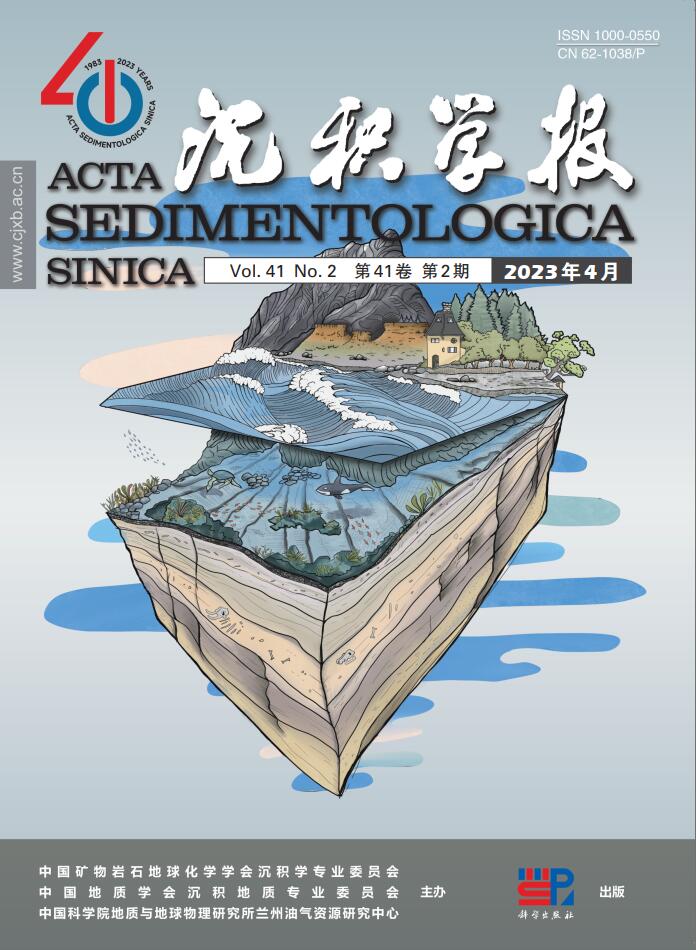


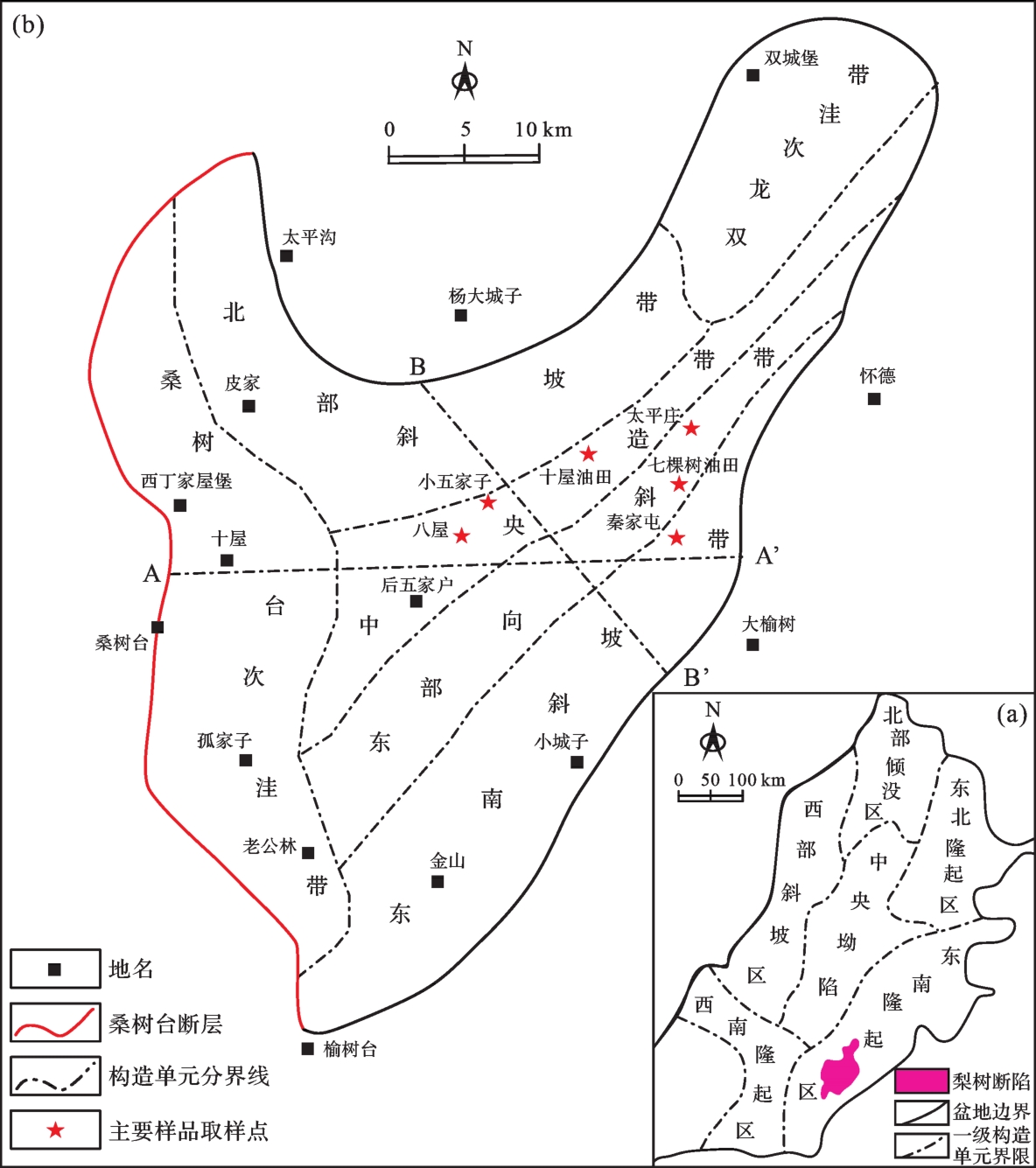










 DownLoad:
DownLoad:

